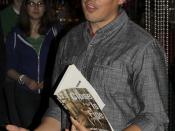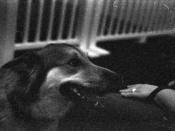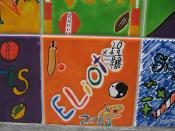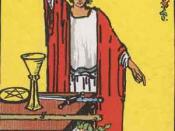Early in T.S. Eliot's The Waste Land- in the first segment, no less- a character by the name and reputation of clairvoyant Madame Sosostris is introduced. Though this is the only section in which she appears, the fortunes she tells through her "wicked pack of cards" are driving elements in the poem as each incident she foretells eventually comes to pass, though arguably this could easily be contributed to Madame Sosostris's vague divinations (as all divinations are). Eliot himself disclaims in his footnotes of the poem any definite knowledge of the contents of a standard tarot deck, so of the seven cards this clairvoyant draws and presents, only two are authentic cards at first glance, the others have apparently been crafted for Eliot's own story-telling benefit in a what looks to be a deliberate exhibit of poetic license. Despite this proclaimed lack of tarot knowledge on Eliot's behalf, I posit that elements from a standard tarot deck (cards not even drawn from Madame Sosostris's deck) work their way into the poem in several of the characterisations, events, and in the idea of death and rebirth.
Much like the surface-deep prophesies of Madame Sosostris, the very history of tarot as both a card game and an occult practice is vague and generalised. As a practice of divination, tarot- like many other fortune-telling methods- is unreliable in the real world and was conceived from something different entirely; tarot knows its roots as a European card game, and though its exact origin is uncertain, we know it made its way through Italy in the fourteenth century and then France in the sixteenth century (Currie, 723). The original name is something, at least, that most sources can consent on, carte da trionfi (cards of the triumphs), an Italian name referring to the cards in the deck used as trumps, and was eventually renamed Tarrochi (Currie, 723). Additionally, an elusive element in the history of tarot in general is the date of tarot's first recorded use in the occult, it is as murky as the date in which the game was initially conceived; another general conclusion most sources reach is that there was no written evidence documenting the use of tarot cards in divination until around the eighteenth century.
The modern esoteric tarot deck was largely developed by scholar and mystic Arthur Edward Waite and was released prior to 1911 (the publication date of his book, Pictorial Key to the Tarot); it is comprised of seventy-eight cards, twenty-two being the major arcana (greater secrets), also known as the trump cards and bearing no suits, and fifty-six as the minor arcana (lesser secrets) divided into four groups of fourteen according to their suits. The trump cards are, in this particular order, the Fool, the Magician, the High Priestess, the Empress, the Emperor, the Hierophant, the Lovers, the Chariot, Strength, the Hermit, Wheel of Fortune, Justice, the Hanged Man, Death, Temperance, the Devil, the Tower, the Star, the Moon, the Sun, Judgment, and the World. In addition to their use in divination sessions, the major arcana also tell a story that begins with the Fool, a naïve young man and follows throughout the deck of the major arcana in what is known as the "Fool's Journey;" the minor arcana tell no story on their own, but they do aide in the potency of a trump when drawn in a card-reading session (tarothermit.com). The minor arcana are much like a standard deck of playing cards, featuring "the court" consisting of a page, a knight, a queen, and a king and then the ten cards exclusive to either a suit of swords, wands, coins, or cups.
The cards Madame Sosostris pulls in The Waste Land are the Phoenician Sailor (drowned), Belladonna (the Lady of the Rocks), Man with Three Staves, the Wheel, the One-Eyed Merchant, a blank, and the Hanged man and of these seven, the Man with Three Staves (more commonly known as the Three of Staves) and the Hanged Man are actual members of a tarot deck, though it is possible that the Wheel is the Wheel of Fortune and that the One-Eyed Merchant is the Mage, which, too, are authentic cards. In his essay, "Eliot and the Tarot," Robert Currie poses the suggestion that perhaps the Phoenician Sailor and the Lady of the Rocks are also minor arcana cards, the Ten of Swords and the Queen of Wands respectively (730), though Betsey B. Creekmore's follow-up article, "The Tarot Fortune in the Waste Land," she speculates that the Queen of Coins would be a more appropriate representation of this Lady of the Rocks (913). Regardless of the supposed identities of these unaccounted for cards, Eliot acknowledges in his footnotes that the events foreseen by the diviner were fulfilled by the poem's end, and indeed they have. Most immediate to a reader unfamiliar with the nuances of each tarot card, is the fulfilling of Sosostris's warning to "Fear death by water," in section four of the poem that is titled, "Death by Water," coupled with the appearance of the drowned Phoenician sailor. However, what of the other cards in Madame Sosostris's deck, the ones not drawn? Interestingly enough, there are prophetic achievements and characters that embody very nearly all of the major arcana within the poem.
Upon inspection, the most immediate connection between the major arcana and The Waste Land is in the card titled the Hermit, a highly suitable visual presentation of the "fear in a handful of dust" segment in part one and that the protagonist of the poem, Tiresias, could be well-represented in the form of the Magician. Indeed, the card's very background image is appropriate for the dry setting presented to us in the second verse, the card's setting is traditionally depicted as a stark desert landscape. He is also so introspective on life's lesson that he has become the lesson (Waite, 10) and we see this quite effectively in the beckoning call to, "(Come in under the shadow of this red rock)/ And I will show you something different from either/ Your shadow at morning striding beside you/ Or your shadow in the evening rising to meet you/ I will show you fear in a handful of dust," where the speaker promises a lesson unlike any we've likely ever experienced. Just as the Hermit makes an appearance in the form of one bearing sage-like knowledge, so does the Magician manifest in the form of the speaker, Tiresias, as a diplomat. Though the visual representation of the Magician is a youthful male, the knowledge that a keyword used to identify this card is "diplomacy" (Waite, 110) as a testament to Tiresias' disastrous mediating of an argument between Zeus and Hera, that he wears an ouroboros (a serpent devouring its own tail, a potential connection to the copulating snakes disrupted by Tiresias that resulted in his seven-year experience as a woman), and that it is insinuated in Waite's write-up on the matter that the Magician is the bridge between Heaven and Earth (Waite, 29) support Tiresias' identity as the Magician.
The presences of other cards is from the major arcana are far more subtle. The Wheel of Fortune hides in part two in the transition of scenes from the paranoid, yet lavishly bedecked upper-class woman to the two middle/lower-class women drinking in a pub; the Wheel can be interpreted as a change in station or position, represented here in a changing scene with different socially-ranked characters. The Justice card appears in its inverse form, as a life out of balance, throughout the poem; the Lovers, too are inversed in this underlying trend of sex without commitment or resulting offspring, the Tower looms in the background as a source of distress, and Strength in reverse echoes the disheartened and defeated feeling that emanates through the poem's duration (Waite 110-111).
Where some cards are only present vaguely, the High Priestess, the Empress, Death, and the World cards all tie in significantly with The Waste Land's theme of death and rebirth, all represent rebirth in part or as a whole and display overlapping interpreted meaning. The High Priestess is often coupled with such words as secret and mystery and "the future as yet unrevealed" (Waite, 110); she is shown to be wearing a crown demonstrating the lunar cycle, a series of waning and waxing, a sort of death and rebirth. Through such ideas in The Waste Land as past problems never truly vanishing (but rather they take on a similar yet different shape) the Priestess is constantly fulfilling her purpose by assuming new forms to avoid true death.
According to Waite, the Empress is a mother figure in her fruitfulness (110), something the poem as a whole lacks in its sterility, but she, too, bears a promise of redemption through rebirth; on the Rider-Waite card her gown is embroidered with a repeating image of a fruit bearing a suggestive likeness to a pomegranate. In Greek mythology, the pomegranate is the fruit eaten by Persephone, daughter of Earth-goddess Demeter, and Persephone is consequently whisked away to the underworld to spend an eternity as Hades' bride, but permitted to visit her mother at the surface for a portion of the year. The half of the year Persephone spends with her mother sees the Earth in bloom and full of life, though when her daughter must return to her fate Demeter's sadness creates autumn and winter. It is through this eternal rebirth of the seasons connected with that one fateful fruit that the image on the gown of the Empress gives hope.
Death is an unexpected candidate for a list of cards entailing a rebirth, and yet the image on the Rider-Waite Death card is a far more explicit testament to this claim than the images of the High Priestess and Empress are. Emblazoned on his black banner, Death sports the image of a rose, life; there's a paradox at work in the image of the Death card, Death bearing life. The Death card suits the end of the poem more than it would suit any other segment, for the entirety of The Waste Land has been dry, thirsting, and dead, so with the final breaking of the sky in an act of pouring down rain, a chance for life is granted to this cracked land.
The World is the remaining card intimating revitalization, and just as it is the final card in this short list of similar cards, it is also the final card in the major arcana. Also known as the Universe or Time, the World card is, "the state of the restored world when the law of manifestation shall have been carried to the highest degree of natural perfection" (Waite, 49). This card, just through the weight of its name, is one I speculate encompasses the entirety of the poem; just as the card signifies the larger scope of the Fool's Journey, so too is it a large-scale view on the scenarios of The Waste Land as a whole.
Works CitedWaite, A.E. Pictorial Key to the Tarot. London: W. Rider, 1911.
Little, Tom Tadfor. "The Hermitage: Tarot History," 2001. 14 Oct 2007 .
Lentricchia, Frank. "Cultural Readings: Modernism, Ideology and Desire." T.S. Eliot The Waste Land: Essays, Articles, and Reviews. Wes Selby, New York: Colombia UF. 1999.
Creekmore, Betsey B. "The Tarot Fortune in The Waste Land." ELH. 49 (4): 908. Winter, 1982.
Currie, Robert. "Eliot and the Tarot." ELH. 46, (4): 722. Winter, 1979.





